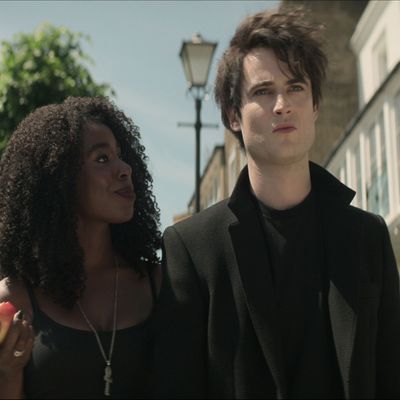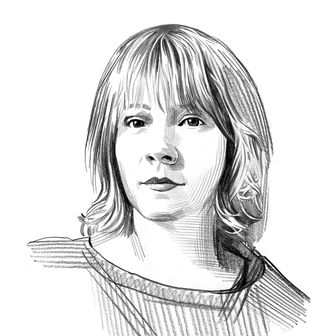
YouTube essayist Maggie Mae Smith is in the middle of a takedown of Joseph Campbell and the Hero’s Journey. For those who never took a comp-lit class, Campbell theorized that there’s really only one story we tell, and it’s about a solitary dude. This dude is called to adventure by circumstances, is mentored and trains up, only to eventually have to face his demons alone. He succeeds and returns home changed. End of monomyth. It should be glaringly obvious that there is more than just this one story to tell. And yet much of the media industry is fixated on this single narrative and the idea that if you really want to satisfy an audience, you have to follow this blueprint.
Well, Dream has just completed a monomyth cycle, and he feels like shit. Your move, Joseph Campbell.
Having punished those who captured him, reclaimed all his tools, and becoming more powerful than he’s been in centuries, Morpheus finds himself empty now that he doesn’t have a quest to occupy his mind. He needs a loving kick in the dick, and who better to do it than his big sister Death? Played by Kirby Howell-Baptiste, Death is a cutie and furthermore a sweetie. She is a font of infinite compassion; in her line of work, she’d have to be.
Sandman’s Death is one of the most beloved personifications of that particular life change that’s ever been written. Dumb, racist corners of the internet erupted when it was announced that a Black woman would be taking the role of everyone’s favorite perky goth girl. That reaction wasn’t just ugly, it was wrong, as Howell-Baptiste is killing it as Death. She has a knowing smile that is so reassuring and kind, and she’s had it since The Good Place, so everyone really should have known better.
Death takes Dream on her rounds, showing how she handles her incredibly fulfilling work. She’s there to ease people through life and death, like one of those fancy death doulas I see on TikTok. I’ve always found this personification of Death extremely comforting. She’s like a soccer mom, taking you out of the game and saying she’s proud of you for trying. Each end-of-life vignette we see in this episode is beautiful in its own way. “When the first living thing existed, I was there,” she says. “When the last living thing dies, I’ll put the chairs on the table, turn out the lights, and lock the universe behind me when I leave.” Who better than Death to teach you how to live?
Sturridge gives a good sibling performance in this segment. There’s a very lived-in affection between him and Howell-Baptiste. His micro-expressions give away that he cares for his sister and enjoys her company, despite Dream’s general veneer of ennui. You can tell he loves being needled by her — and she has good reason to be needling. When the Endless get existential, they’ve been known to fuck off, as is hinted at here. Death doesn’t want another sibling going AWOL.
Death argues that Dream doesn’t need a purpose beyond his function, that what they do is important enough to be their purpose. But Dream’s domain is all about things just out of reach, so by being unfulfilled and wistful he is kind of fulfilling the assignment. At the start of the episode, Death says this Gloomy Gus phase isn’t like Dream, but isn’t it? Almost as if to prove my point, the rest of the episode focuses on another one of Dream’s little tantrums.
This episode is an adaptation of two different issues of the comics, and boy does it show. “The Sound of Her Wings” and “Men of Good Fortune” aren’t even in the same trade paperbacks; that’s how disconnected they are. I wonder how this episode plays for someone who hasn’t dived deep into Sandman lore (and who doesn’t have the tramp stamp to prove it). Would the bifurcated nature of the stories feel even weirder, or does the fact that both pieces involve Death marry them together well enough?
Dream meets Hob Gadling in 1389, in the middle of another one of Death’s pep talks. He seems to need one every millennium or so. She’s taken him to the White Horse pub, right outside of London. There, he meets Hob — a guy who has decided that dying is “a mug’s game.” Dream and Death do a li’l She’s All That–style bet. Death will refrain from taking him, unless he truly wishes to die. And Dream will check in on him every 100 years.
We get a real bird’s-eye view of English history through these century-spanning chats, with cameos from William Caxton, Chaucer, Christopher Marlowe, Johanna Constantine I, and William Shakespeare. I hope we get to see his other Sandman stories someday. We also get a full history of men’s fashion, via Hob and Dream’s fits. Sturridge looks great in Elizabethan garb. Rococo … less so.
Eventually, Hob says he suspects Dream really wants a friend. Like all those reality shows that claimed to be social experiments, Morpheus’s real motivation was entertainment. Dream can’t fight the friendship accusation, but boy does he try. He gets so huffy! What does it say about Dream that he’ll continue to associate with a guy in the slave trade but he’s indignant at being perceived as vulnerable?
Poor Hob thinks that Dream has dumped him for good when he doesn’t show up in 1989. But we, the audience, know he’s still all bubbled up. And when gentrification comes for the White Horse, it seems like our pals will never reconcile. But, aw, it seems like Hob opened up a new pub right next door to the old one. And after getting sorted out by his sister, Dream seeks out his only real friend.
Fables and Reflections
• The opening of this episode references the “Feed the Birds” scene from Mary Poppins, and there’s a depressing story about that! Would you like to read it? The music in Mary Poppins was written by the Sherman Bros., as depicted in Saving Mr. Banks and the documentary The Boys. After Mary Poppins premiered, and for the rest of his life, Walt Disney would occasionally go to the Sherman Bros. office and say, “Play it.” That meant they were supposed to play “Feed the Birds,” one of the most melancholy songs in the entire Disney catalog, about how rare and special it is to care for something smaller than yourself. Walt also had to get a PT massage and have a Scotch before driving home every day, because he’d sustained an injury playing polo and was in excruciating pain every single day of the rest of his life. Anyway, nice song.
• One more piece of trivia: What Hob says about Shakespeare (“Acts a bit, wrote a play”) is a reference to the infamous review of Fred Astaire’s screen test: “Can’t act, can’t sing, can dance a little.”
• The parallel pub chats in 1389 and 1989 during the Hob Gadling section of the episodes are so choice. My dad loves to remark that some of the earliest extant correspondence is two older people in ancient Egypt commiserating that the kids today wear too revealing clothing and have no respect. In a time of perpetual apocalypse, it is somewhat comforting to know that people thought the world was ending way back when.
• We get a little more “muahahahaha” acting from Desire, who claims to be behind Roderick Burgess’s little scheme. Will they be the unseen hand of fortune in the back four episodes? The answer is yes, obviously.
• I do wish Death had her signature eyeliner.


